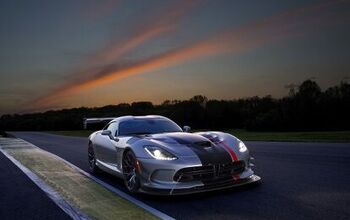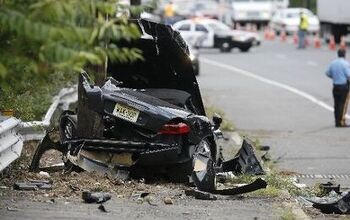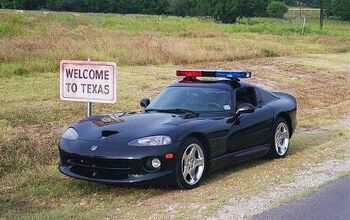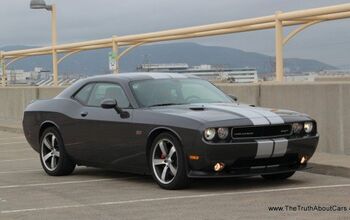Chrysler's Crushing Vipers

In what is shaping up to be a public-relations disaster for Chrysler, the company has decided to crush as many as ninety-three first-generation and pre-production Vipers. Worst of all, they’re forcing a community college in Puget Sound to crush prototype despite the fact that the school is still using it to train students. The question is: why?
And then… well, rumor (as reported by various blogs) says that a couple of these Vipers were crashed on public roads, costing Chrysler millions of dollars in fines and settlements. Early Vipers can be challenging to drive enthusiastically, although they’re no worse than any other, um, ten-cylinder car with no traction control and a hood the length of the USS Hornet‘s flight deck. The “loan agreements” under which the Vipers were given to their current custodians give Chrysler the right to demand their destruction, and the rumor is that Chrysler is giving those destruction orders in order to prevent further liability hassles.
Not so, claims Chrysler:
About 10 years ago, Chrysler Group donated a number of Dodge Viper vehicles to various trade schools for educational purposes. As part of the donation process, it is routine, standard procedure — and stipulated in our agreements — that whenever vehicles are donated to institutions for education purposes that they are to be destroyed when they are no longer needed for their intended educational purposes.
With advancements in automotive technology over the past decade, it is unlikely that these vehicles offer any educational value to students.
Also, Chrysler Group has no record of any legal proceedings involving Dodge Viper vehicles donated to educational institutions being involved in accidents and product liability lawsuits.
To recap, the Vipers in question have no significant historical value, have not been involved in any accidents and serve no educational purpose – which is what they were designed to do at first.
Hmm.
It would be easy to pick the blog entry apart, and the enthusiast community is doing just that. The only thing I’ll say here is this: The notion that ninety-three early Vipers, taken together, have no significant historical value — well, that’s ridiculous. Imagine if ninety-three pre-production ’53 Vettes were to become available. Hell, imagine if ninety-three pre-production ’83 Vettes were to become available. These cars have value to someone. At the very least, they should be released into a race series or some sort of historical collection. A “Viper Ranch” with all of them bleaching under the desert sun would be better for future generations than this decision.
Chrysler’s done a lot to earn the respect and admiration of “car guys” over the last few decades. From the Shelby Charger to the old Viper ACR, the company’s tried hard to give us the most speed for the least money. But this cowardly crushing of Chrysler’s own history is a dark day in that history. It won’t be forgotten.

More by Jack Baruth
Latest Car Reviews
Read moreLatest Product Reviews
Read moreRecent Comments
- THX1136 What happened to the other companies that were going to build charging stations? Maybe I'm not remembering clearly OR maybe the money the government gave them hasn't been applied to building some at this point. Sincere question/no snark.
- VoGhost ChatGPT, Review the following article from Automotive News: and create an 800 word essay summarizing the content. Then re-write the essay from the perspective of an ExxonMobil public relations executive looking to encourage the use of petroleum. Ensure the essay has biases that reinforce the views of my audience of elderly white Trump-loving Americans with minimal education. Then write a headline for the essay that will anger this audience and encourage them to read the article and add their own thoughts in the comments. Then use the publish routine to publish the essay under “news blog” using Matt Posky listing the author to completely subvert the purpose of The Truth About Cars.
- VoGhost Your source is a Posky editorial? Yikes.
- Fed65767768 Nice find. Had one in the early-80s; loved it but rust got to it big time.Still can't wrap my head around $22.5K for this with 106,000 km and sundry issues.Reluctant (but easy) CP.
- El scotto err not be an EV but to own an EV; too much training this week along the likes of what kind of tree would be if you were a tree? Sorry. Bring back the edit function.


































Comments
Join the conversation
When I worked for the local Utah Infiniti dealer in 1992, the community college in town had a first-generation Q45 test mule donated (or loaned) to them under similar conditions. We borrowed it back and converted it to a race car to run at the Bonneville Salt Flats. Modifications included a full roll cage, fire extinguisher, nitrous injection, low rolling-resistance racing wheels and tires, and lots of obnoxious sponsor decals. Unfortunately, the engine was so tired from whatever flogging Nissan had used it for that it blew on the first pass at Bonneville. We then became responsible to find another engine for it before returning it to the community college. Its racing career a failure, I always wondered what ended up happening to it.
This really ticks me off, ever since I heard about it from my brother last week. Since Fiat now owns Chrysler, couldn't those schools have said "screw you, Old Chrysler went bankrupt and is dead and gone, we're keeping them!" I'm sure it's not that simple, but this was a really dumb move on Mopar's part.